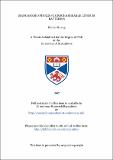Files in this item
Manganese spinels for rechargeable lithium batteries
Item metadata
| dc.contributor.advisor | Bruce, FRS Peter | |
| dc.contributor.author | Huang, Haitao | |
| dc.coverage.spatial | 185 p. | en_US |
| dc.date.accessioned | 2018-05-30T08:34:04Z | |
| dc.date.available | 2018-05-30T08:34:04Z | |
| dc.date.issued | 1997-06 | |
| dc.identifier.uri | https://hdl.handle.net/10023/13603 | |
| dc.description.abstract | The synthesis, characterisation and performance of lithium manganese oxide spinels have been studied in terms of their application as cathode materials in rechargeable lithium batteries. A new air stable synthesis based on a solution route has been proposed. Powder X-ray diffraction demonstrates that formation of single phase spinel is possible at temperatures as low as 200 °C. Chemical analysis indicates that the compositions of the spinels prepared by the new solution route depend on the firing temperature. A temperature of 200 °C gives a composition of LiMn2O4.1 and the oxygen content decreases with increasing firing temperature, reaching LiMn2O4 .02 at 600 °C and LiMn2O4 at 800 °C. TEM indicates that the solution based spinels possess small particle sizes, less than 1 ?m. All these characteristics differ markedly from the highly stoichiometric and crystalline spinel prepared by traditional solid state reaction over 800 °C. Electrochemical cells based on the new spinel cathodes were constructed and subjected to galvanostatical cycling at a high discharge rate of C/2 for 300 cycles (charging at C/4). The material fired at 200 °C exhibits excellent performance at 3 V cells. An initial capacity of around 140 mAhg-1 is obtained, very close to the theoretical capacity (148 mAhg-1 ) expected for LiMn2O4 . An enhancement of capacity retention by nearly 50 % after 300 cycles is obtained if < 1 wt % of carbon is added to the solution during synthesis. After 300 cycles, 64 % of the initial capacity remains. The spinel prepared by the solution route and fired at 600 °C gives excellent performance in 4 V cells. An initial capacity of 120 mAhg-1 is obtained and around 75 % of capacity remains after 300 cycles. Ex-situ X-ray diffraction and electrochemical studies such as ac impedance and cyclic voltammetry including the use of microelectrodes were carried out to understand self-discharge and capacity loss on cycling. Spinel dissolution in the electrolyte as well as layer formed on the electrode surface may play an important part in the cycle life of the 4 V spinel cathode. The capacity loss in the 3 V cells arises from incomplete reversibility of the phase transition between cubic and tetragonal spinel which accompanies each cycle. | en_US |
| dc.language.iso | en | en_US |
| dc.publisher | University of St Andrews | |
| dc.subject.lcc | TK2891.L5H9 | |
| dc.subject.lcsh | Storage Batteries | |
| dc.title | Manganese spinels for rechargeable lithium batteries | en_US |
| dc.type | Thesis | en_US |
| dc.type.qualificationlevel | Doctoral | en_US |
| dc.type.qualificationname | PhD Doctor of Philosophy | en_US |
| dc.publisher.institution | The University of St Andrews | en_US |
This item appears in the following Collection(s)
Items in the St Andrews Research Repository are protected by copyright, with all rights reserved, unless otherwise indicated.

